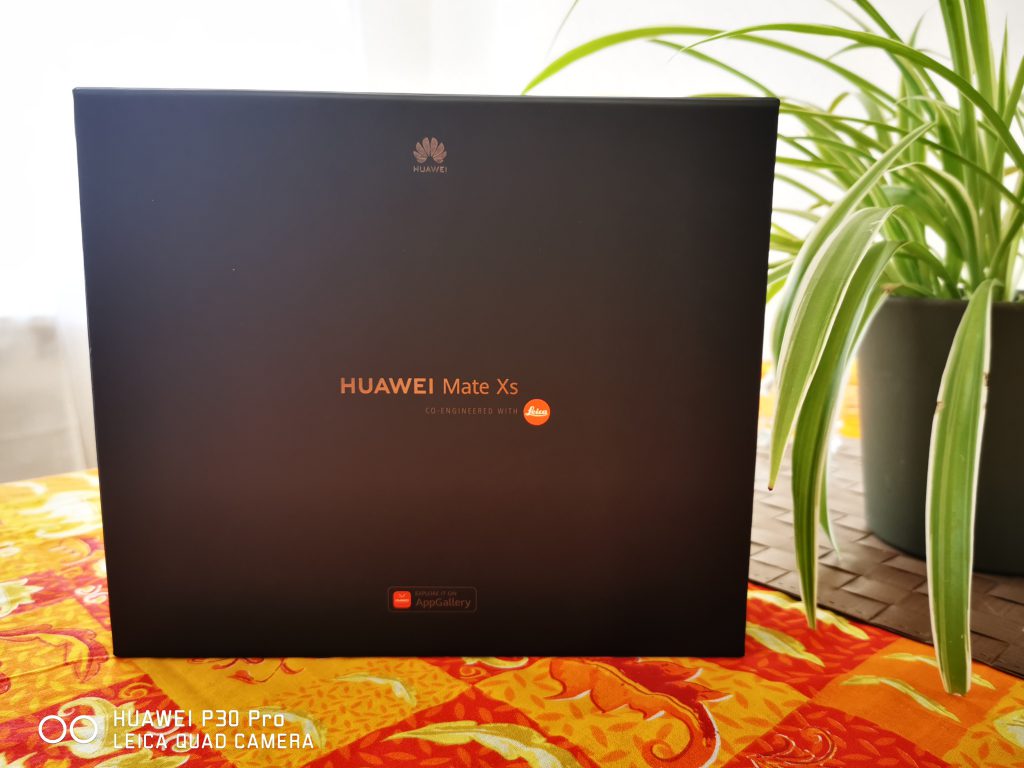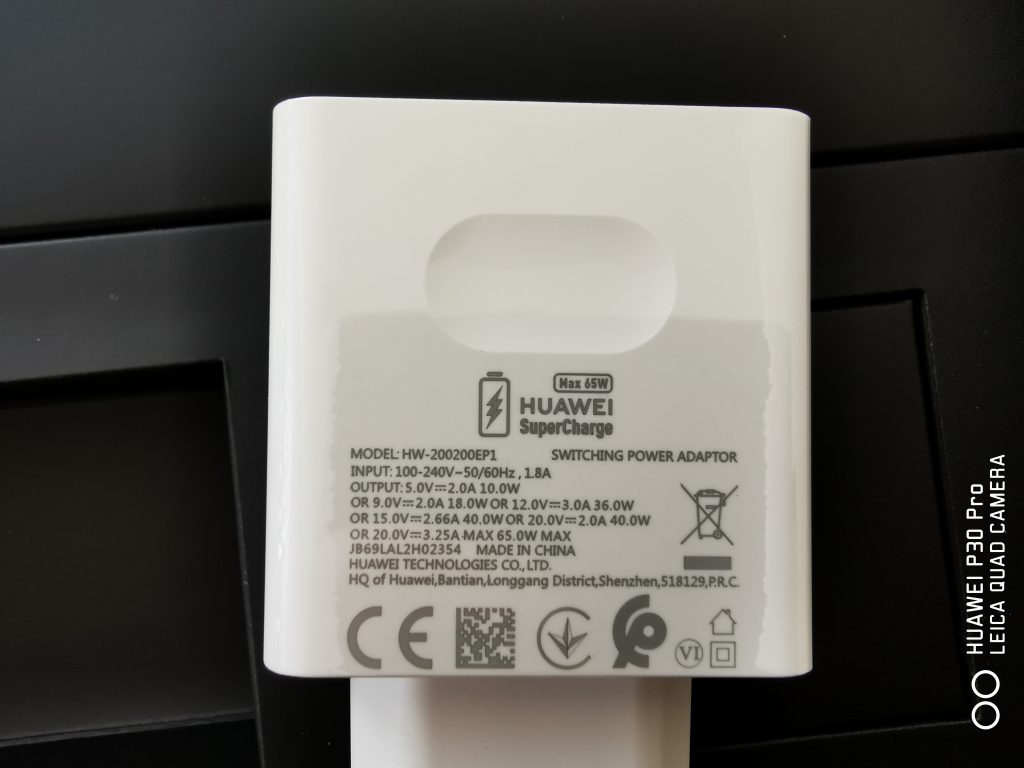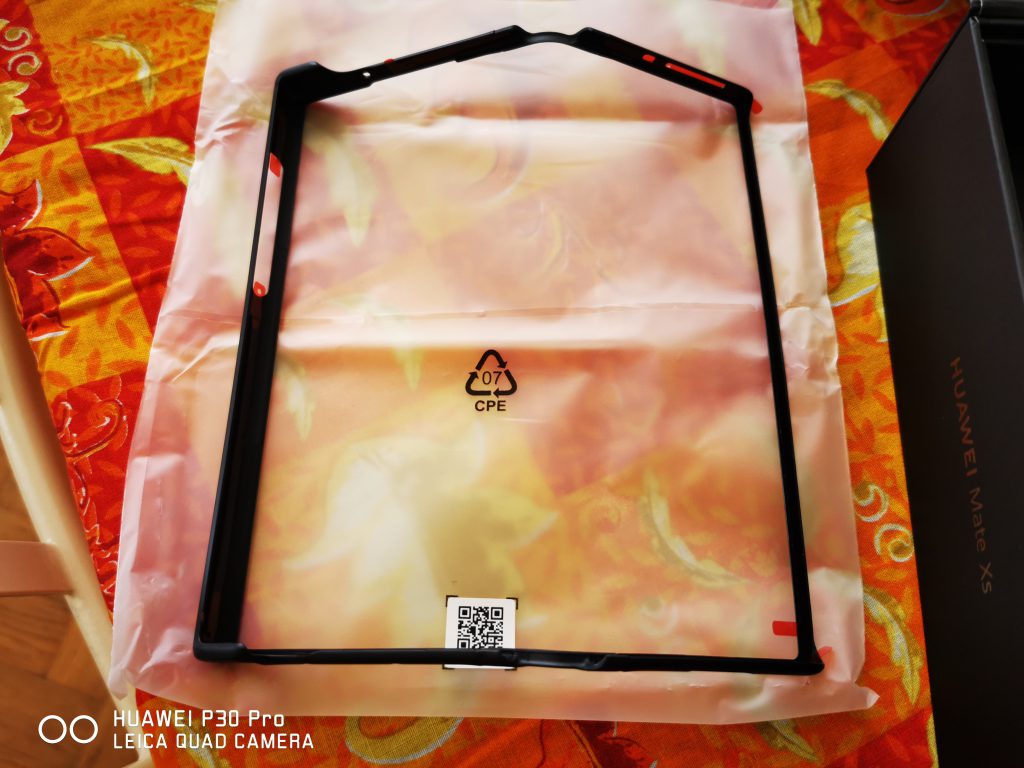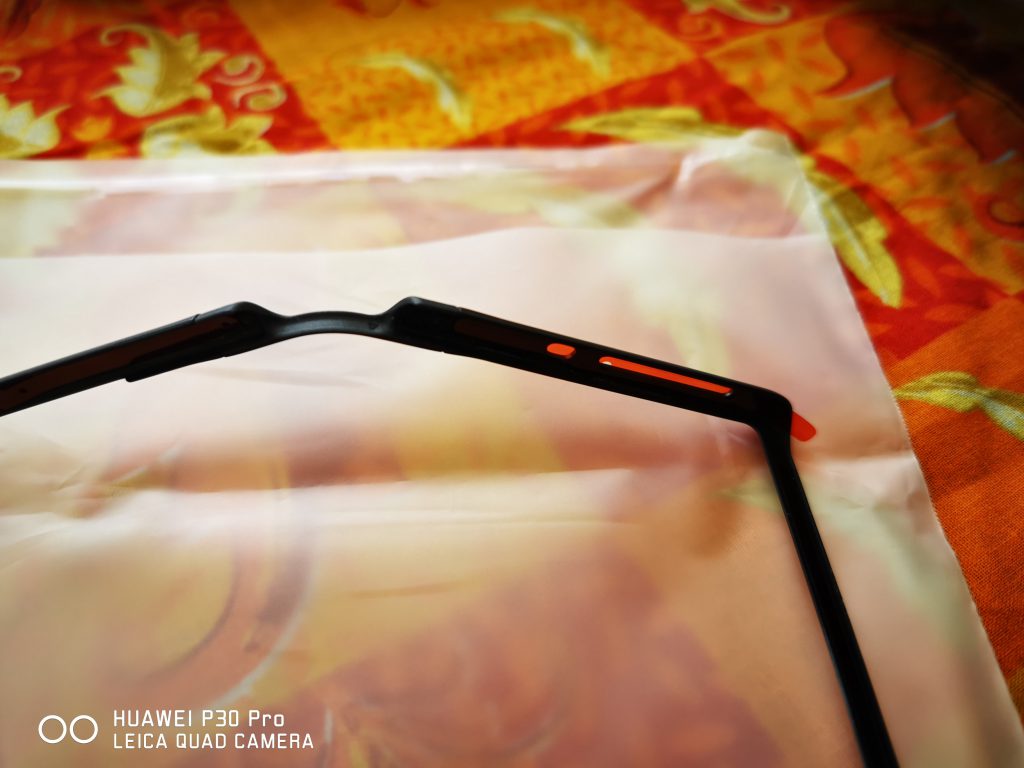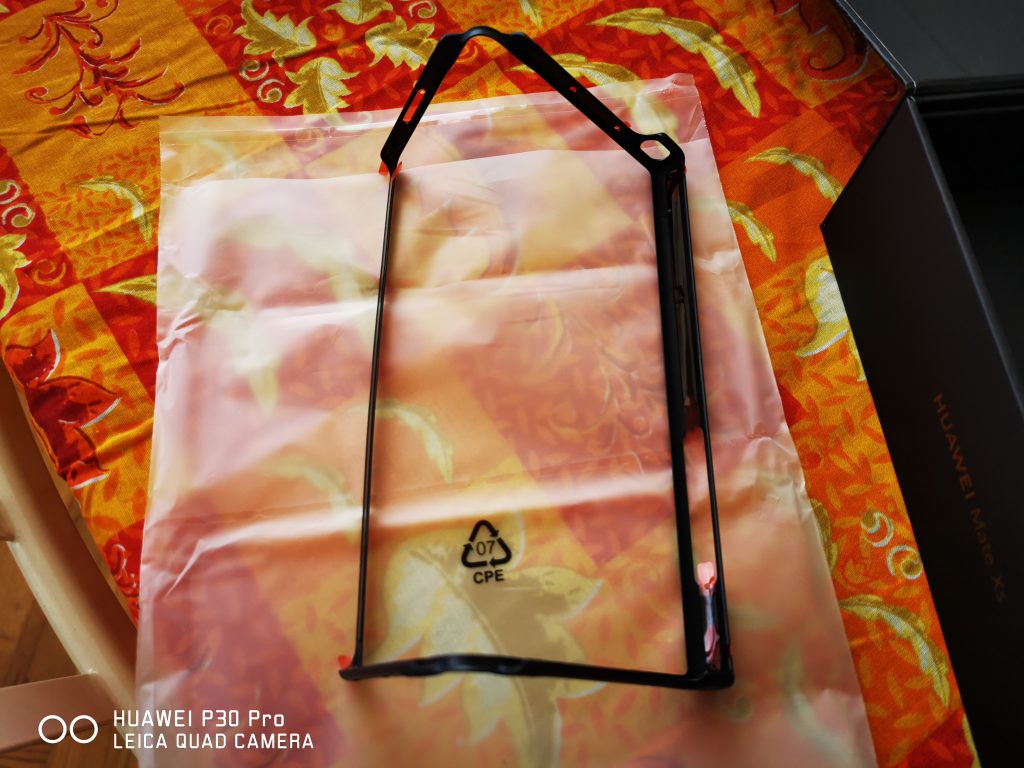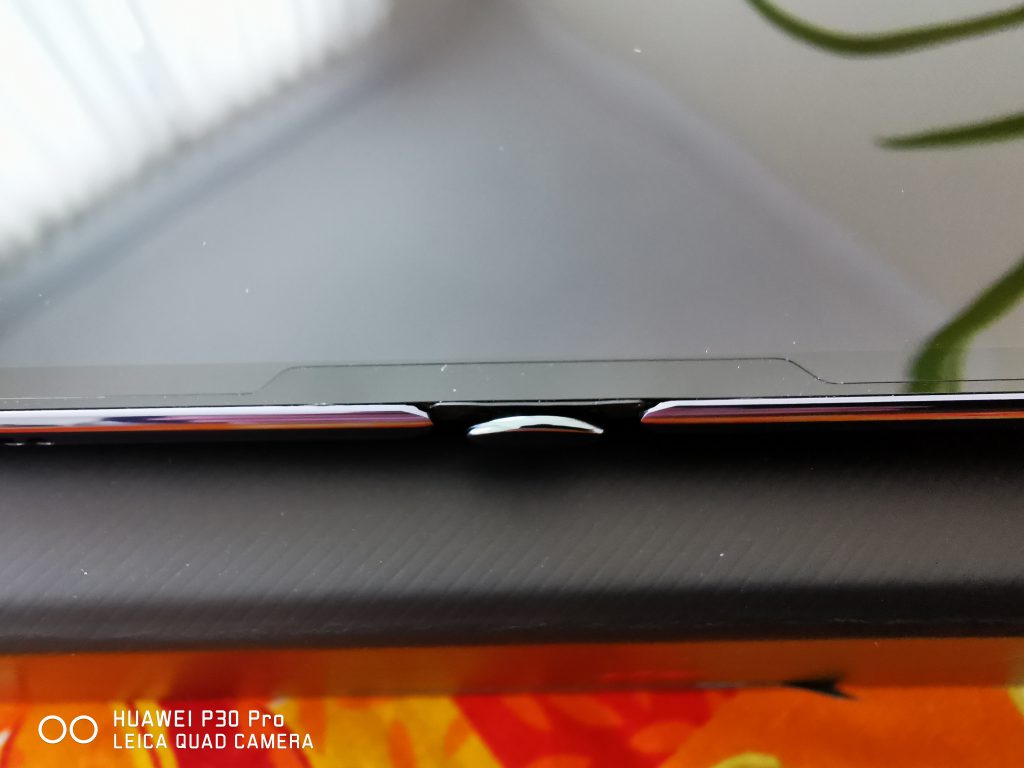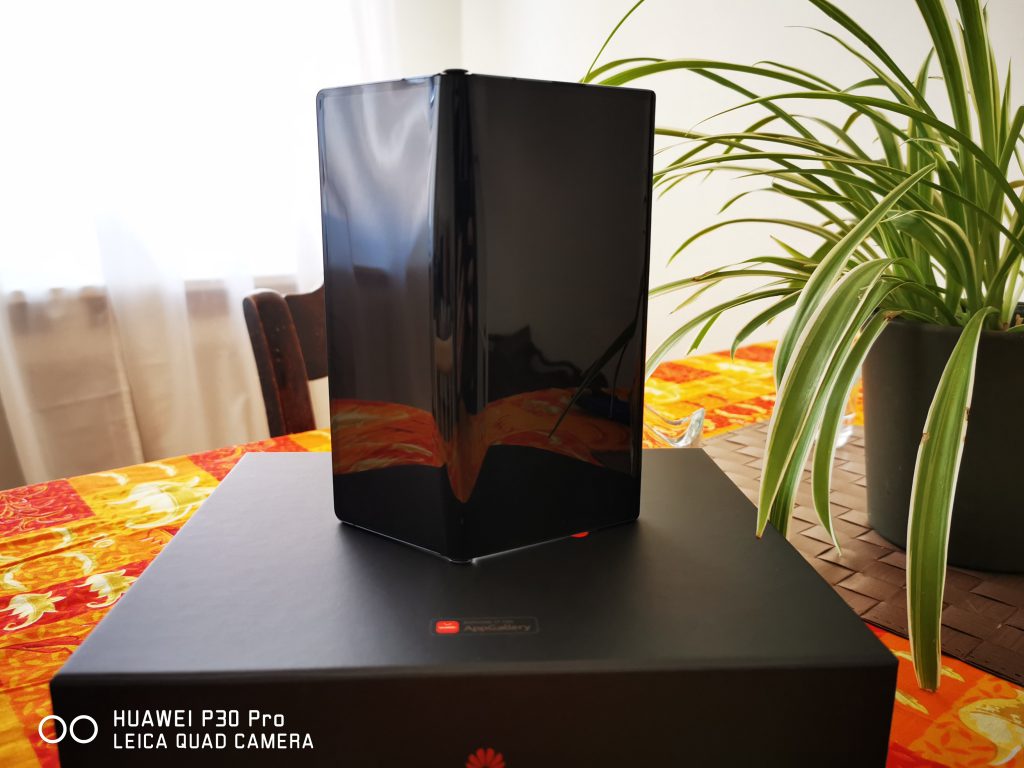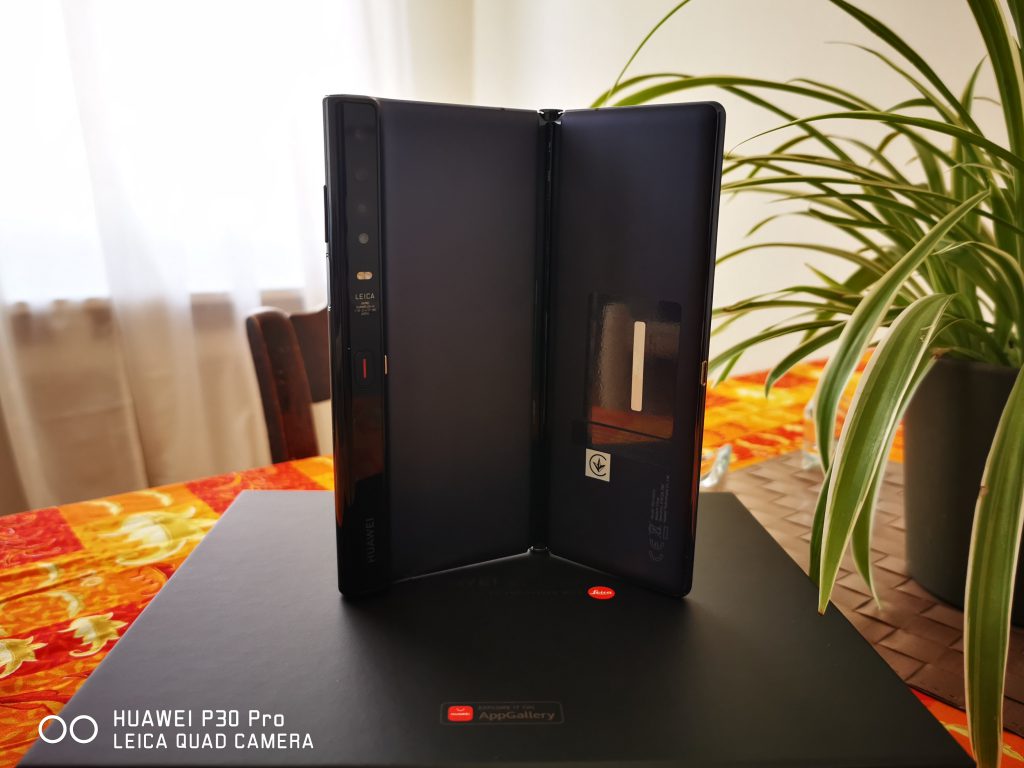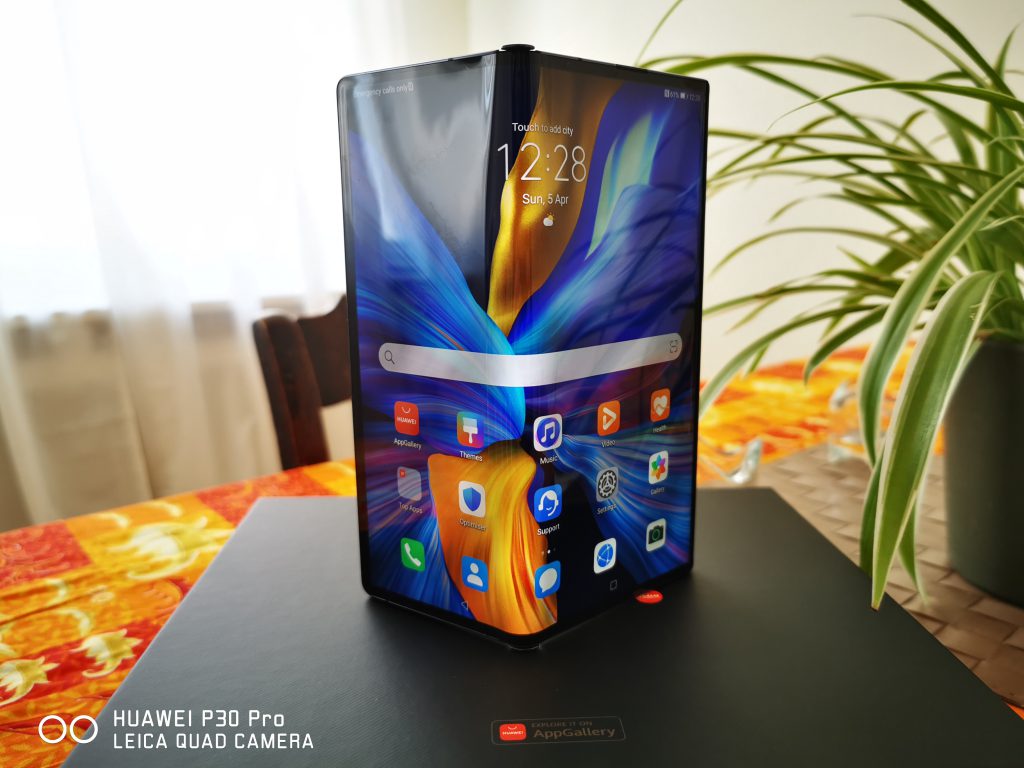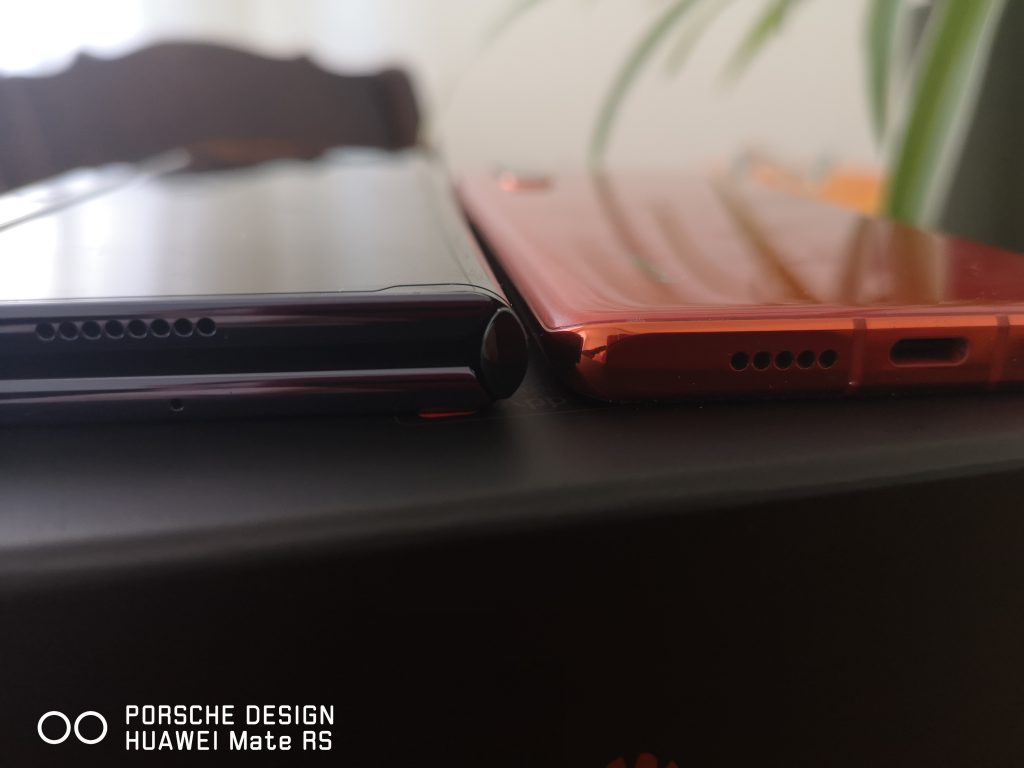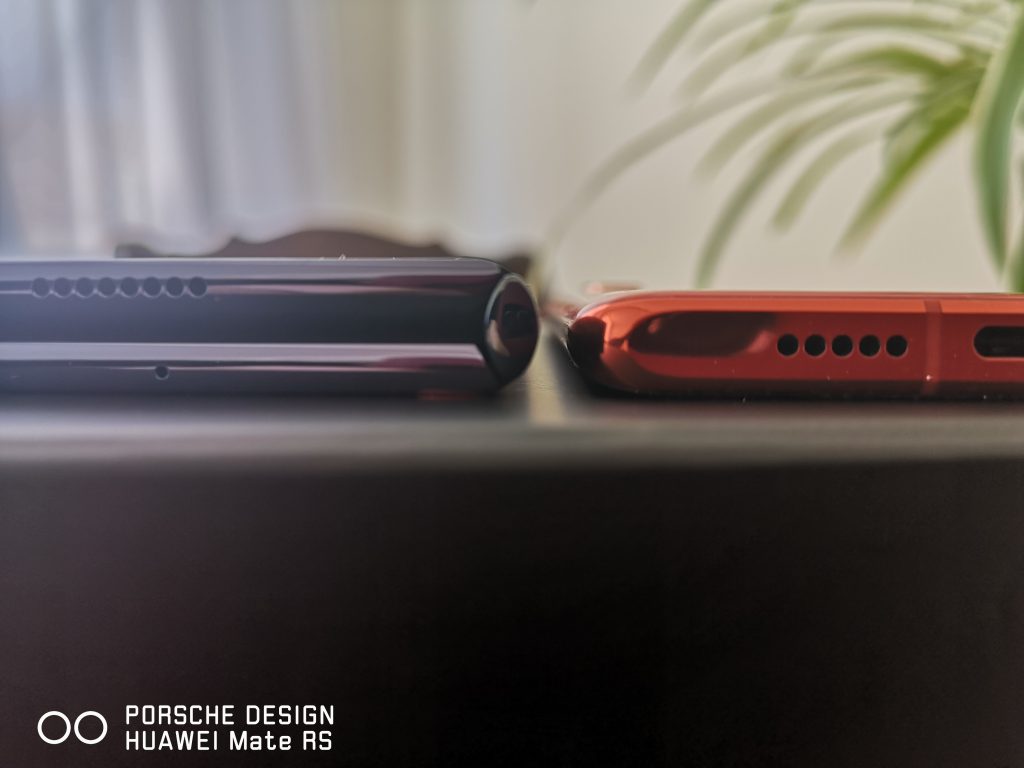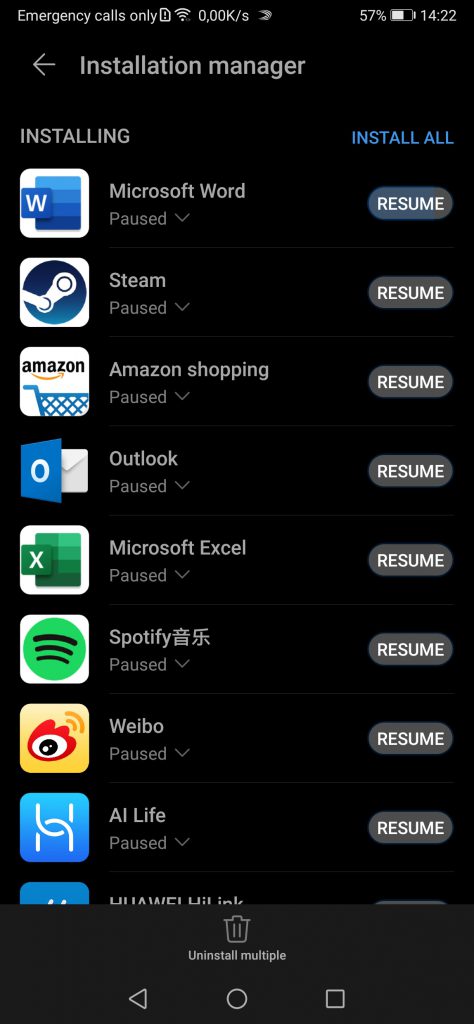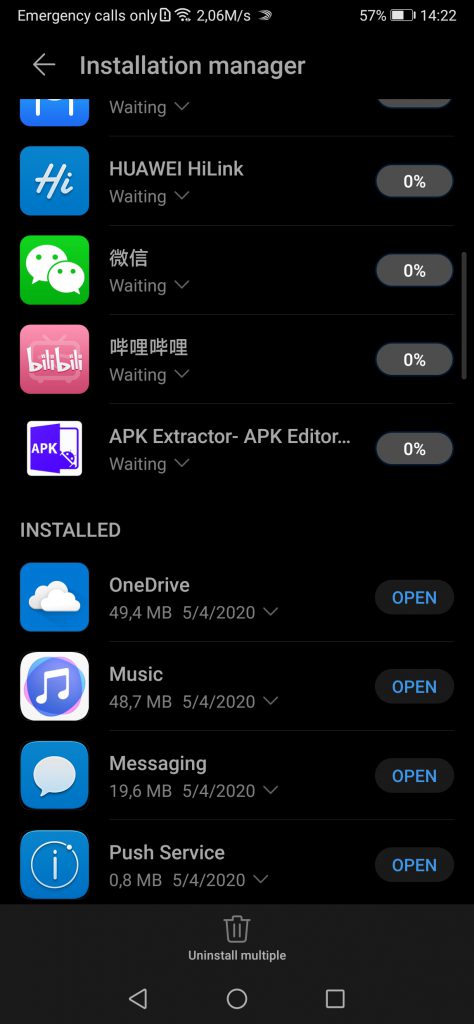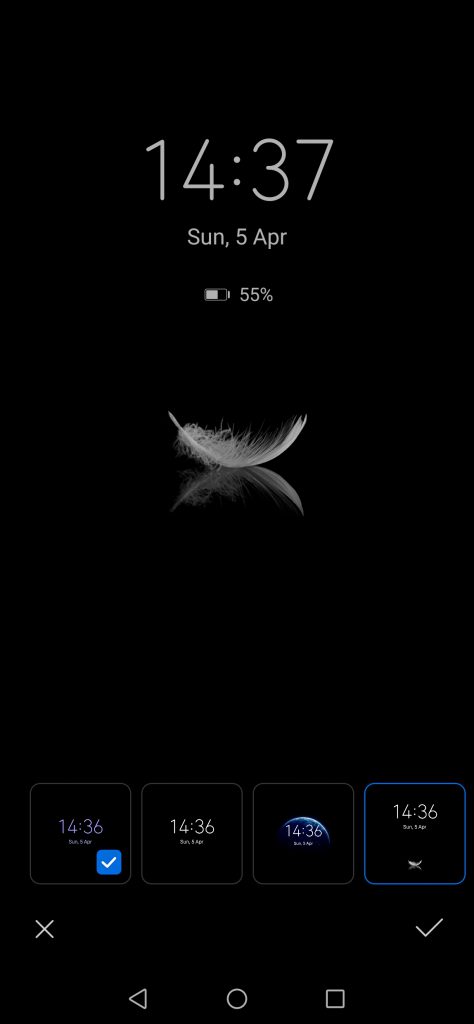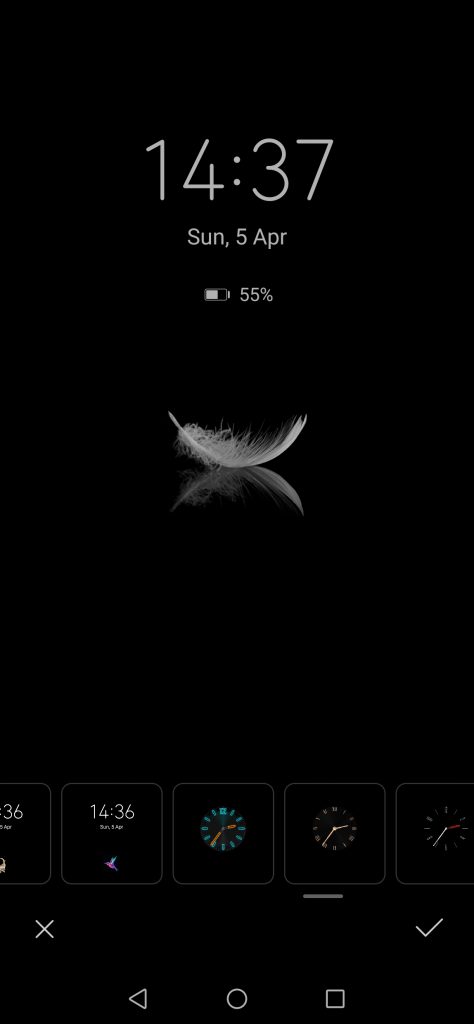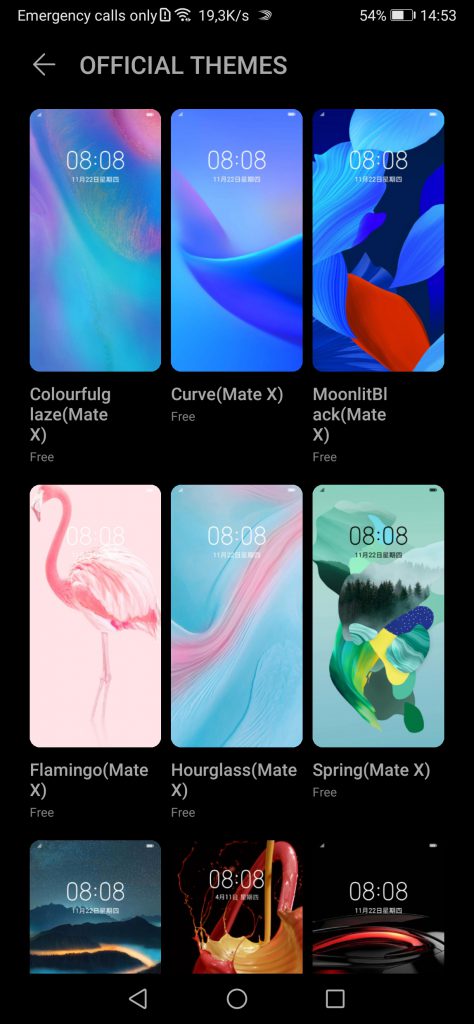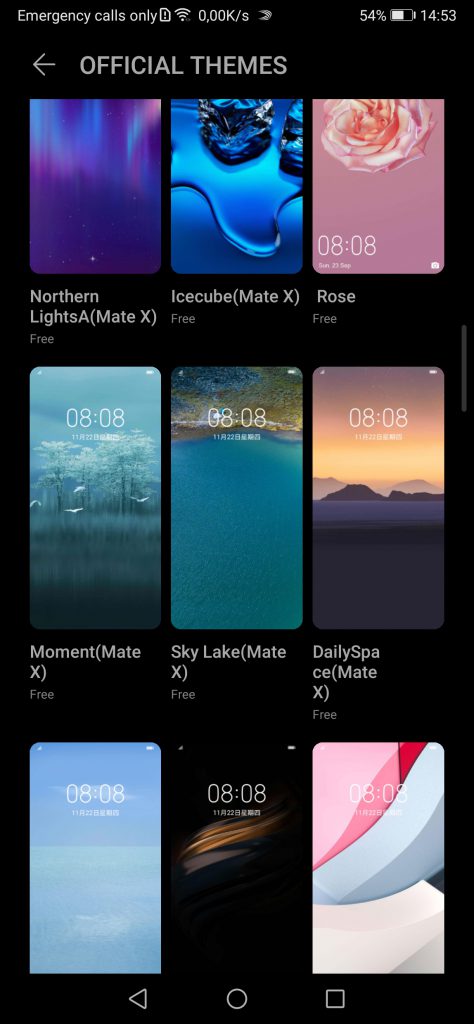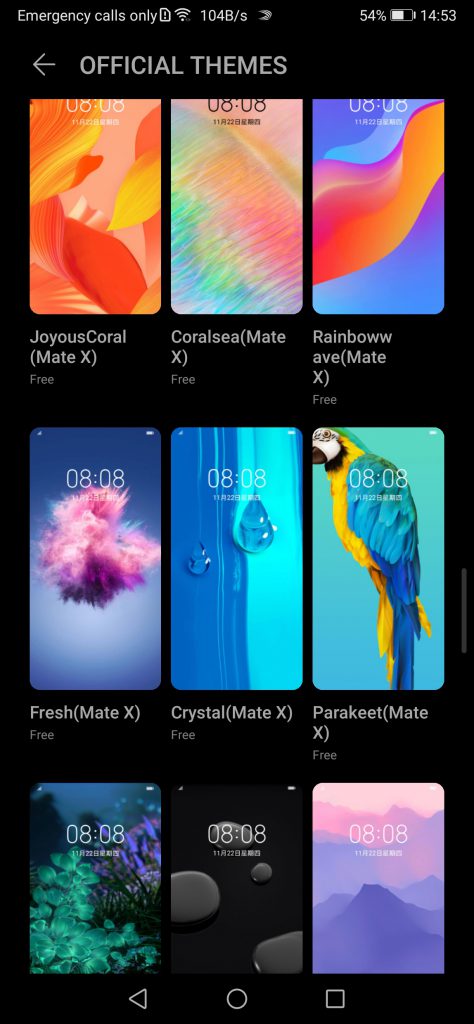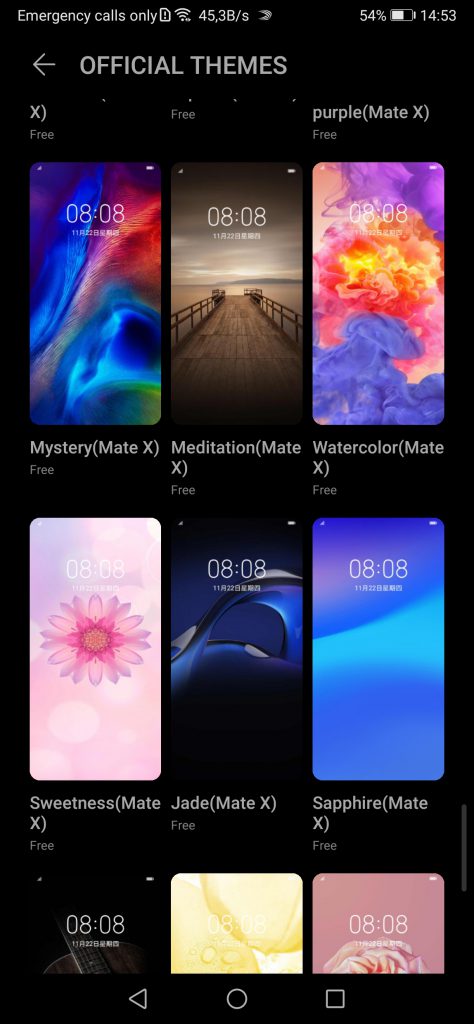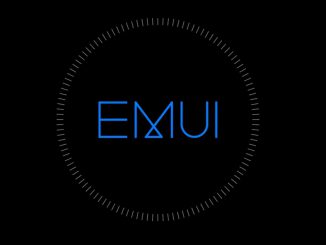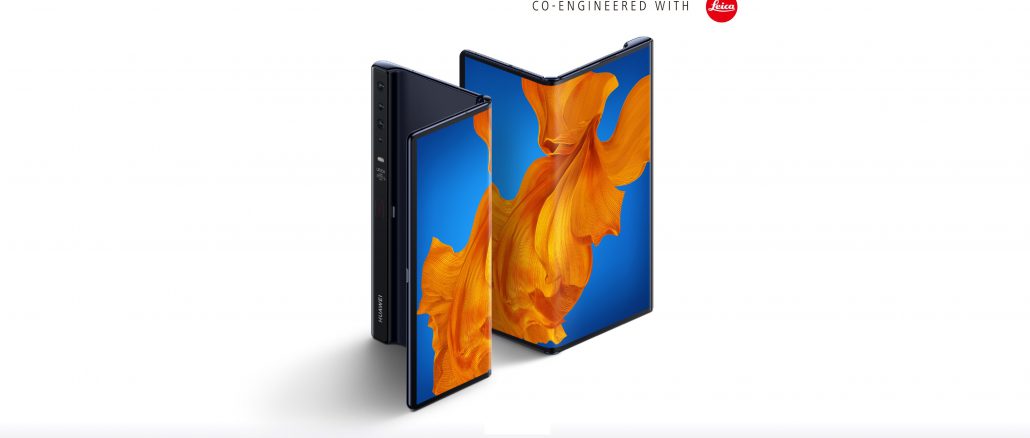
The Huawei Mate Xs is the manufacturer’s second try at a foldable phone. Here’s our unboxing and first impressions of it.
Artículo disponible en Español | Article disponible en Français
At the end of February, Huawei announced their second-generation foldable phone, the Mate Xs. This is essentially an updated version of the original Mate X, with a stronger screen, newer SoC and optimized software. In this article, we will unbox the device and talk about our first impressions. But, before we start, we want to make it clear that we’ve not received this device from Huawei, and that we actually bought it ourselves. In this specific case, the device costed 2499€, and only came with 50GB of free storage for 12 months on Huawei’s Mobile Cloud. Contrary to some other countries, Belgium did not get a free leather case with the device, meaning that, if we want one, we have to spend 120€ on it, if we can find one.
Now, let’s start by having a look at the specifications of this device:
- Kirin 990 5G (7nm+ EUV)
- 8GB of RAM
- 512GB of internal storage, expandable with Nano Memory cards up to 256GB
- 8” OLED display, 2480×2200 pixels resolution (unfolded)/6.6”, 2480×1148 pixels resolution (folded, main)/6.38”, 2480×892 pixels resolution (folded, secondary)
- 146.2×161.3x11mm (unfolded, screen at 5.4mm)/78.5×161.3x11mm (folded), 300 grams
- Fingerprint reader on the power button, side-mounted
- Quad-camera set-up
on the back, also used as front camera:
- 40MP, wide-angle-lens, f/1.8
- 16MP, ultra-wide-angle-lens, f/2.2
- 8MP, telephoto, f/2.4
- ToF camera
- 4 500mAh battery, divided in two cells of 2 250mAh each, 55W wired charging, 0-85% in 30 minutes, no wireless charging, Type-C
- EMUI10.1/Android 10
- 5G, dual-SIM, WLAN 802.11a/b/g/n/ac (wave2), 2.4/5.0 GHz, Bluetooth 5.0, GPS/AGPS/Glonass/BeiDou/Galileo/QZSS, gyroscope, compass, proximity sensor, hall sensor, infrared sensor, ambient light sensor, barometer, colour temperature sensor
- No headphone jack, no IP rating
- NFC support
- Available in 1 colour: Interstellar blue
- The price is as
follows:
- 8GB+512GB for 2 499€/2 599€, depending on the country
Now that we have the specifications out of the way, let’s have a look at the box of the product. This one comes with a magnetic side to open it, similar to what is already done on the Porsche Design models, giving it a more premium feeling. The box comes with a seal with the first warning, mentioning that “This product is a foldable phone with a flexible screen, and it is normal for a slight bulge to appear on the central seam. If you have any doubts, consult the retailer before purchasing or unpacking”. So far, nothing surprising, as we are aware there’s a bulge on the middle of the display:
Inside the box, we find the Mate Xs unfolded, with a second warning with instructions on how to properly handle the device. The company warns against sand/dust/liquids getting inside the device, as this can damage the moving parts, which makes sense. The company also warns against dropping the phone or scratching the display, with this one being quite fragile. Now, Huawei has added a protective film on top of the screen, similar to what they already do with other devices, which come with a protective film from the factory. While initially one might remember the incident with the original Samsung Galaxy Fold, this protective film on the Mate Xs does not form part of the display itself. Users could, in theory, remove it, but its goal is further protecting the display below it, taking scratches and other abuse and eventually be replaced later on, being cheaper than having to replace the entire display. Lastly, we are told not to fold/unfold the device if the temperature is -5ºC or lower. We had already mentioned this on a previous article. While for many of us this might not be an issue, living in warm territories, for people living in Northern Europe, this severely limits the use of the device in winter:

Taking the phone outside of the box, we find a third warning, although this one has the same information as what is present on the previous warning. This third warning also includes information on how to fold and unfold the device, and warns users to leave the phone unfolded if not used for a long time:
When we remove the first layer, we find a second layer of boxes, containing the various accessories included with the phone, as well as the little pin to remove the SIM tray:

For the first accessory included, we have a 65W SuperCharge charger, used to charge the phone. It is with this charger that we can get the 55W SuperCharge, charging from 0 to 85% in barely 30 minutes. This one can also be used to charge Huawei MateBooks, which explains the 65W. This is further confirmed when we have a look at the charging cable supplied with the phone, which matches the charging cables given with MateBooks:
We also get type-C headphones, being the basic, cheap ones supplied with other Huawei devices. If we are completely honest, it is surprising that, for 2499€, we only get these. At this price-point, one would expect higher-quality headphones, such as the Huawei ANC-3, FreeLace or even the FreeBuds 3. Furthermore, both the headphones, power brick and charging cable are white, while the phone is dark blue/black. The company could have supplied accessories matching the colour of the device, knowing it wouldn’t be the first time they do this, with Porsche Design devices getting black headphones, power bricks and charging cables:
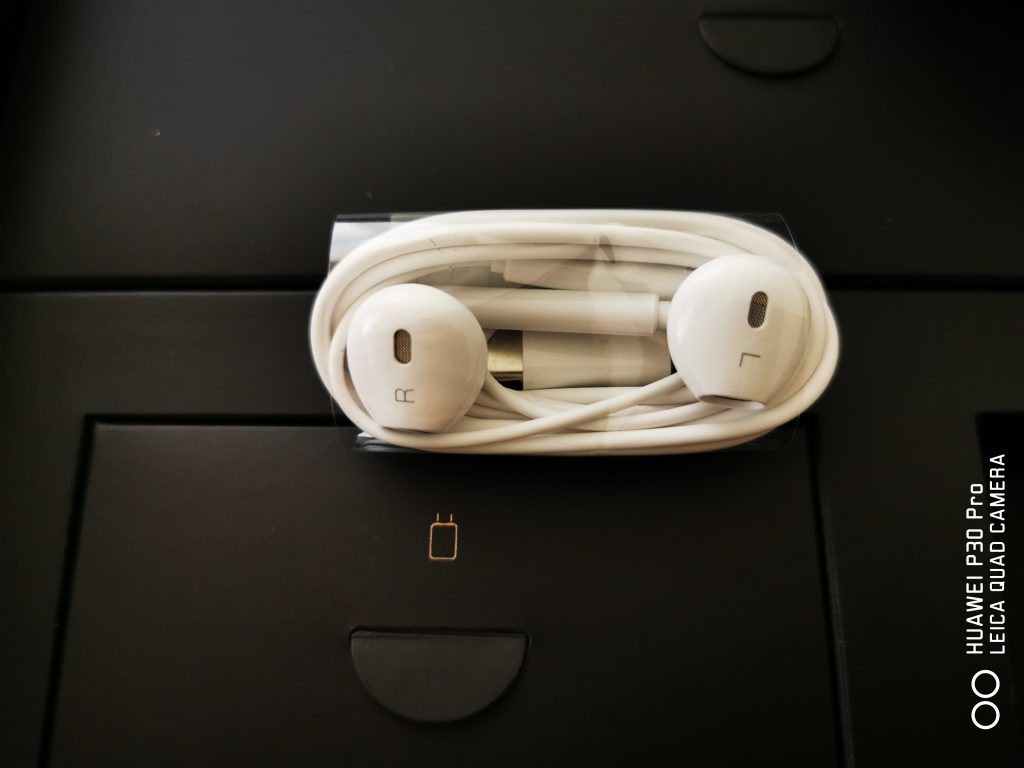
Lastly, we are also given a rubber frame for the device, which protects the frame against bumps and allows the phone to rest on flat surfaces without the screen touching these, thus protecting it a bit more. To keep the protective frame in place, this one comes with adhesive, found under the red tabs, although it can only be used once. This rubber frame can bend, thus allowing users to fold and unfold their device without any issues, contrary to the leather case:
The box also includes the usual warranty information and quick start guide, documents which most of us will just ignore as they aren’t very useful overall:
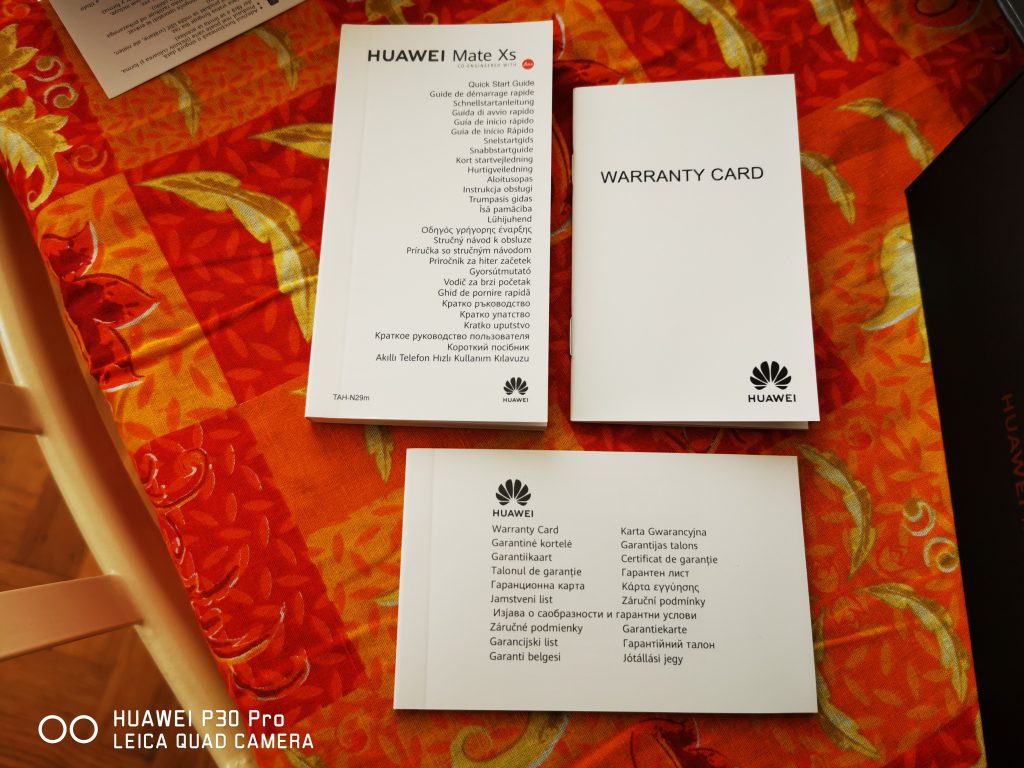
If we now move on to the device, the first impressions are quite good. The device is easy to take in hand, and rather light when unfolded, with the display being impressively thin, similar to the experience of holding a Huawei Ascend P6, even if the P6 is roughly 1 mm thicker. On the bottom of the device, we can find a speaker, the type-C charging port and what appear to be microphone holes:

From above, it is also hard to tell there’s a bump where both parts of the phone join, although this bump becomes more noticeable if looking at it from a different angle. However, this bump is likely similar to the notch on other devices: at first, one will notice it, until getting used to it:

We had previously mentioned the screen protector. This one is barely noticeable, with one having to look really closely to be able to tell it apart from the display under it. It is especially noticeable around the hinge area, where it is slightly smaller, likely to avoid this one coming off while folding and unfolding the device:
On the back of the phone, we find the usual IMEI sticker, as well as the quad-camera set-up. The back panels appear to be made of some kind of plastic, which is slightly disappointing, seeing the price of the device. It would have been nicer if the manufacturer had instead chosen to use aluminium or glass, although there might have been reasons this wasn’t done, such as the already excessive weight of the device, at 300 grams:
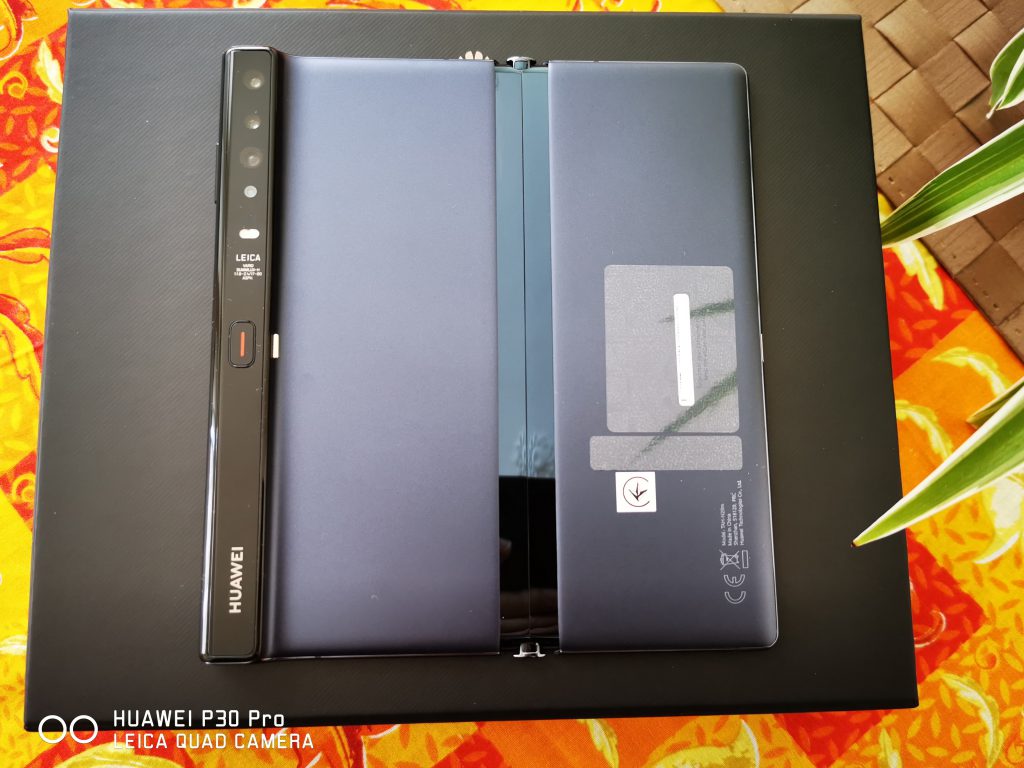
On the thicker side of the device, where the camera is located, we also have the release button to unfold the display, the volume button and the power button with the fingerprint reader integrated. There isn’t much to say about these, apart from their construction appearing to be rather solid:
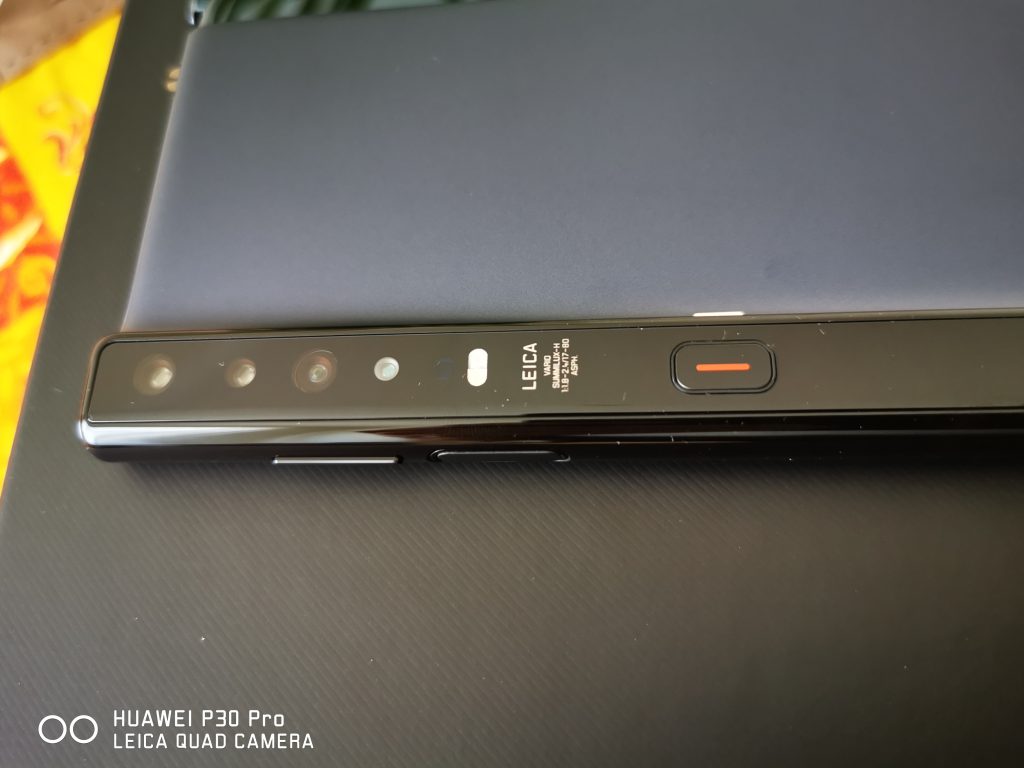
Interestingly enough, the black plastic panels found in the middle, covering the back of the hinge, can move. When folding the display, these black panels retract under the plastic back covers, allowing the hinge/curve to be “flat” and not leave a gap when folded, as seen on other foldables on the market. Whether Huawei took measures to keep dust and other materials out of this hinge is another question, although, without tearing down the device, we wouldn’t be able to say… which we will not be doing:
While on the bottom of the device there’s a speaker and what appear to be microphones, the top is slightly different, with a SIM-tray on one end, an IR blaster, and what is likely another microphone. This time, the hole to eject the SIM-tray is not placed right next to a microphone, as done on the P30 Pro, which led to confusion, making it easier to break this microphone:
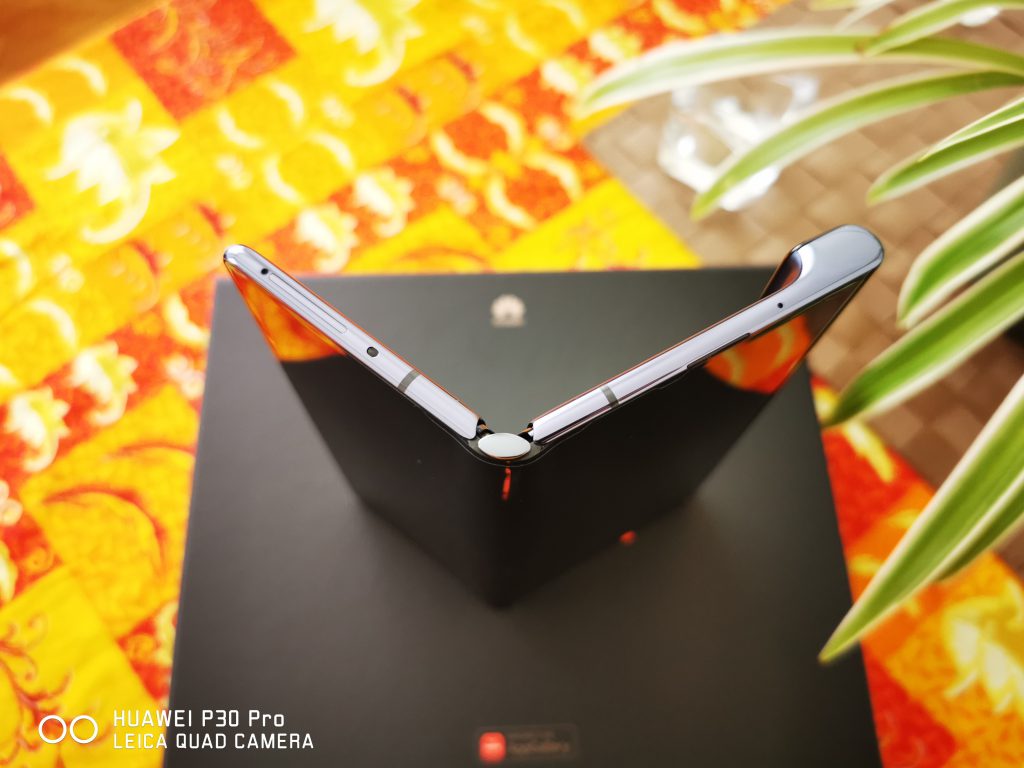
On the previous picture, we can also notice a grill speaker sitting right between the phone frame and its display. This is an interesting design feature, taking in account Huawei has switched to under-display speakers for past models:
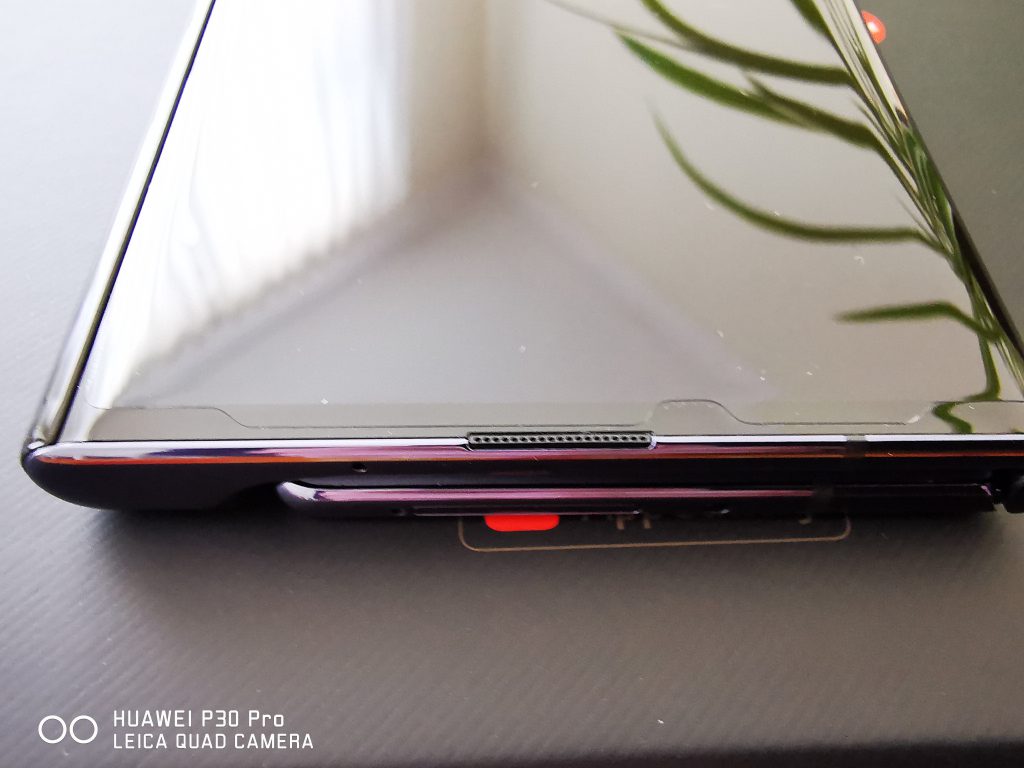
As previously mentioned, when folded, there’s no gap between both parts of the display, which is rather nice to see. This also gives the phone a more compact form-factor, making it easier to take in hand or put in a pocket:
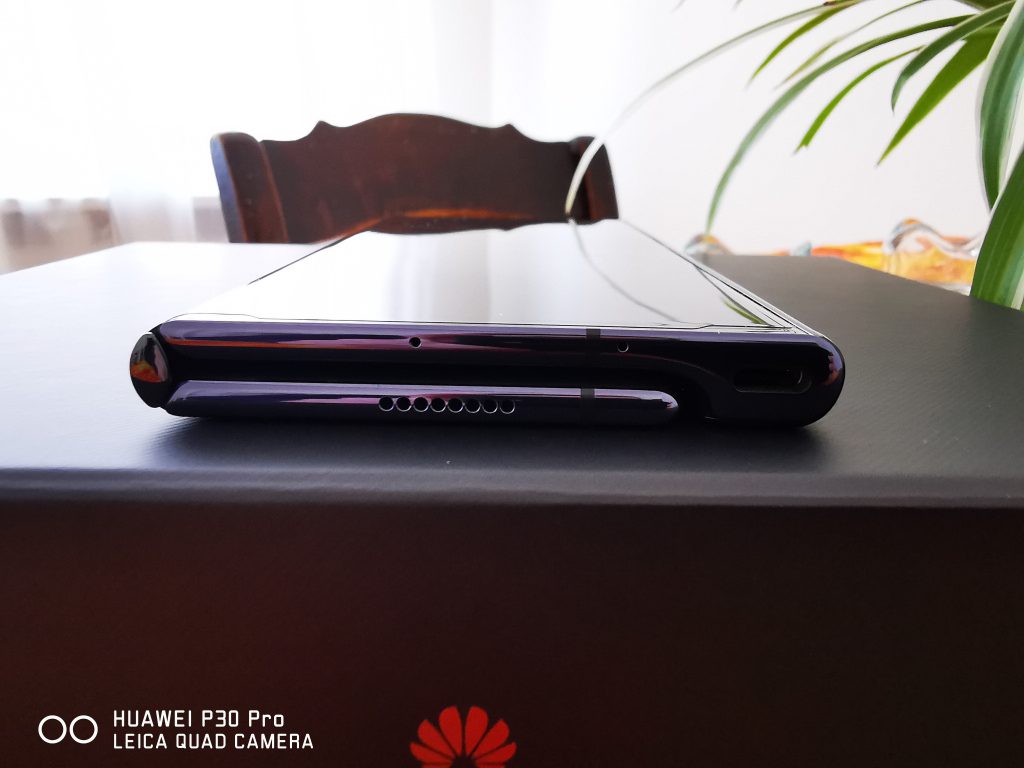
When folded, the device looks just like any other smartphone on the market. With the display being on the outside instead of the inside, it also makes it possible to use it properly when folded, not forcing the user to have it unfolded constantly, contrary to other foldables on the market. Of course, while this is an advantage, it is also a disadvantage, the display being made of plastic instead of glass, and thus being more fragile. The same can be said about the secondary display, on the back, although this display has a rather weird form-factor, making it harder to use:
Turning on the device for the first time brings up a warning message, with, once again, the same instructions we’ve seen multiple times so far. Sadly, even with these instructions, it is likely somebody will completely ignore them and manage to damage or break their device on the first set-up. Then again, human stupidity knows no limits:
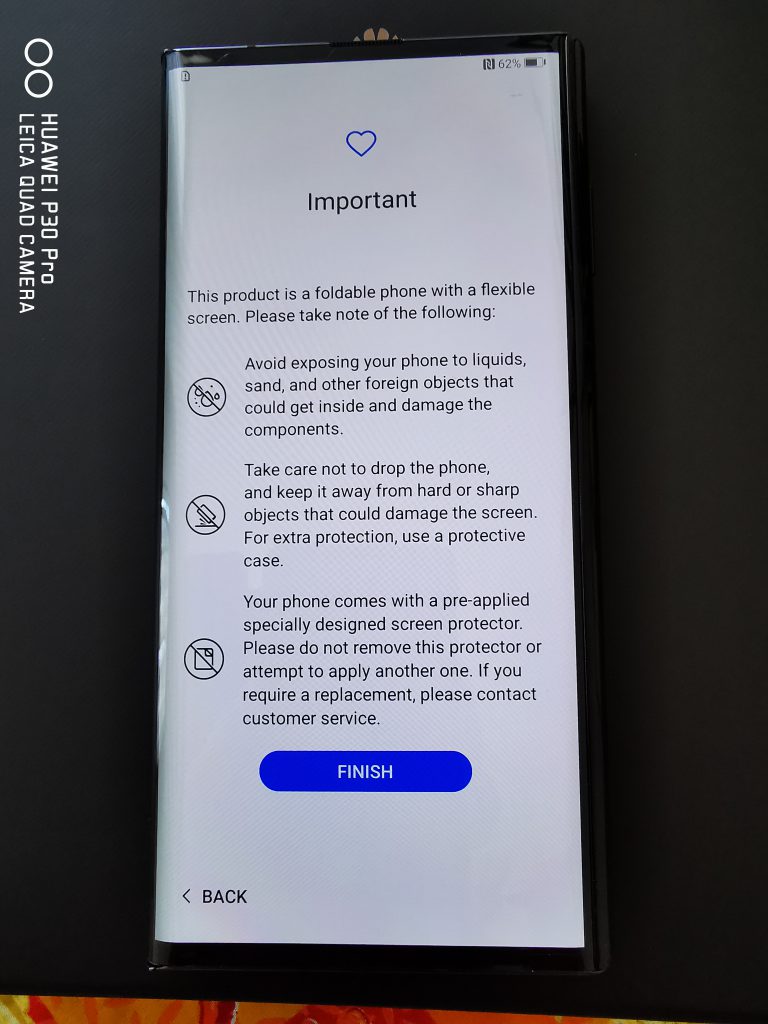
The Huawei start-up animation and sound are impressively loud, more than any other recent Huawei smartphone, which managed to startle us at the beginning, and still startle us whenever we turn off and on the device. While most people will likely turn on the device once and never turn it off again, it is still impressive how good the speakers are, being a rather positive surprise. These surprises don’t stop there, with the colour of the display being amazingly good – even better than the P30 Pro:
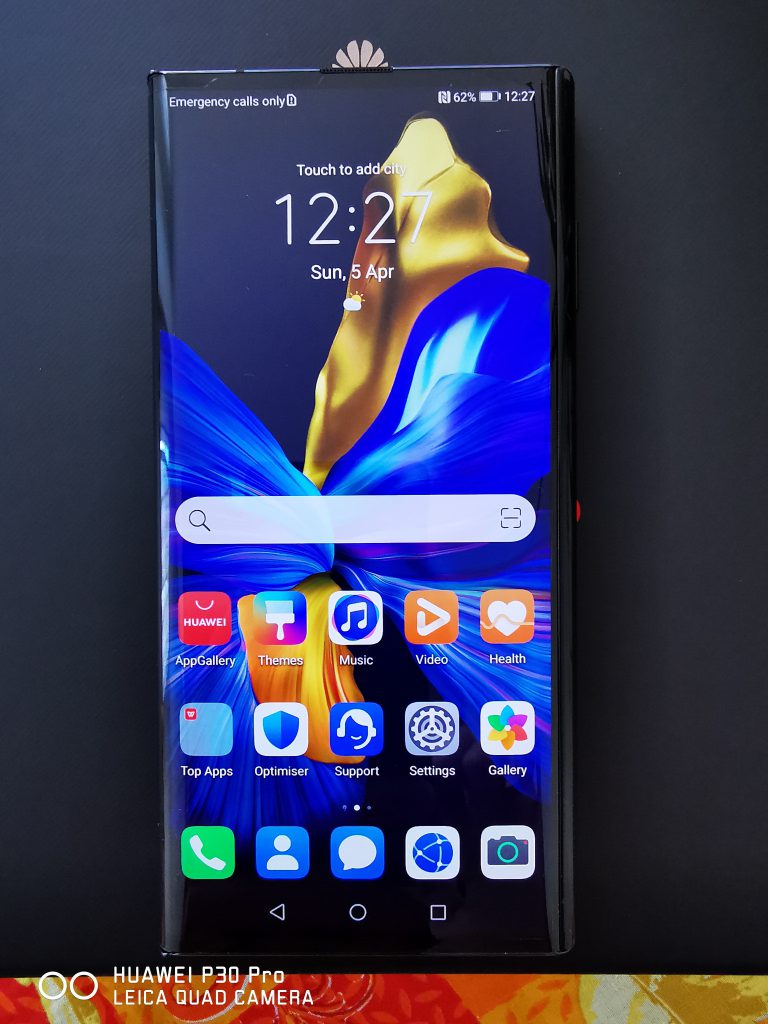
The device can be folded while being on, with this one switching to full-screen mode when unfolded at at least 45º. Below 45º, the device switches to folded mode. While we cannot confirm this, this change appears to be triggered with some kind of hardware switch, depending on how far inside the black panels protecting the hinge are. When unfolded, we are presented with the same display as when folded, except the icons of the applications are much further apart:
To be able to access the “selfie” mode, one has to open the camera app and then press the usual icon to switch to the front camera, although, in this case, the device will instruct the user to flip the device, presenting a “fake” front camera interface:

If we now compare the size of the Mate Xs to the P30 Pro, we can notice how this one is not only taller, but also wider, giving it an aspect close to the Mate line-up. The bezels are also quite symmetrical, with the chin and top bezels being the same size. Interestingly enough, when folded, the device creates a “fake” bezel on the folded size, making the display quite flat, which, for those of us that have been on devices with curved displays for a while, is a rather curious experience. As mentioned previously, the colours on the Mate Xs are a lot nicer than on the P30 Pro, even if, on this picture, the P30 Pro has “Eye comfort” enabled, making colours yellower:
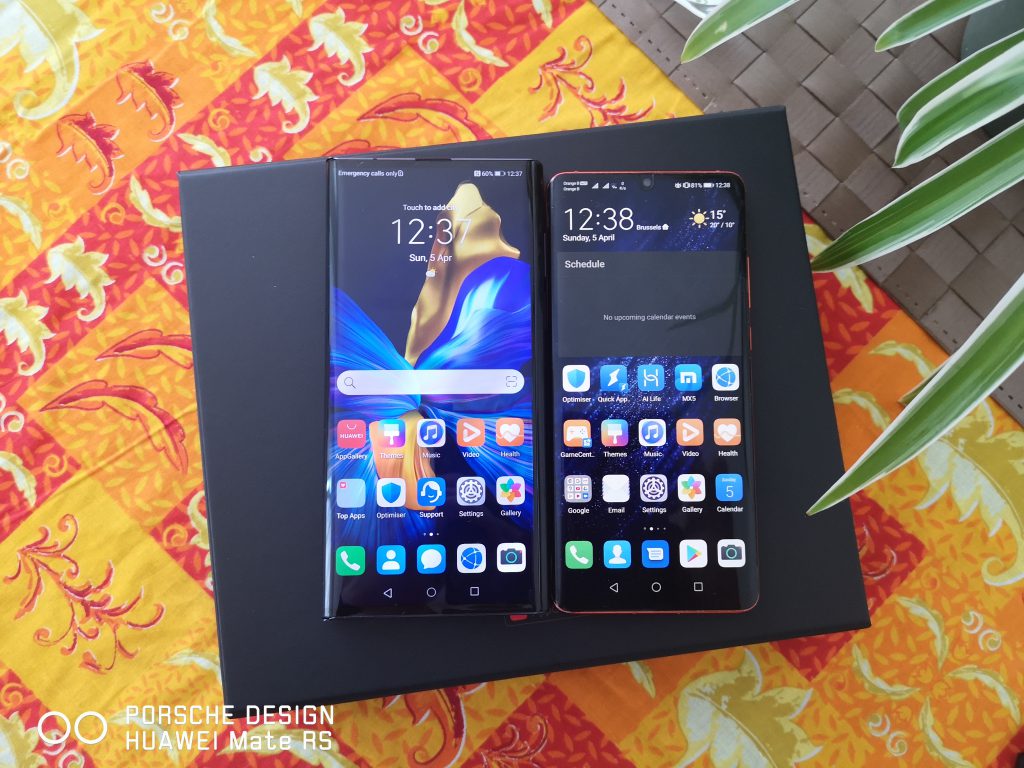
The design of the back is also rather special, with, finally, the loss of the camera bump, another interesting “regression”, for those of us that have been using devices with camera bumps for a while:

Of course, this loss of camera bump is thanks to the extra thickness of the device, although this extra thickness hasn’t translated into a better camera. If anything, it is rather disappointing to see a mix of the P30 and P30 Pro camera on this high-end foldable, with these two having released a year ago. On the Mate Xs, the lack of space means there’s no periscope camera, and thus no x5 optical zoom and x50 digital zoom, instead settling for a x3 optical and x30 maximum digital zoom. To improve the camera and palliate this lack of space, Huawei could have made the device half a centimetre taller, giving it more space to cram a periscope camera vertically, as well as upping the RAM from 8GB to 12GB, as done on the Mate 30 RS Porsche Design, or delaying it until the release of the P40 series. After all, with this device already being quite big, making it slightly bigger wouldn’t have been an issue, resulting in an even larger display when unfolded. Of course, this would have likely led to an even more expensive smartphone….
To end this overview article, let’s have a quick look at the software of the Mate Xs. The device comes with EMUI10.1 out of the box, which includes various optimizations to make use of the extra space on the screen. An example of these various optimizations is a vertical bar, which can be used to access various apps such as the calculator, notepad, or any app that we add to the list. With this feature, users can have two apps, one next to the other, when the device is unfolded, boosting productivity. But things don’t stop there, as we are able to have a third application floating, which can be useful for, for example, making quick calculations with the calculator or taking a note on the notepad.
Most are already aware of this, but the Mate Xs comes with Huawei’s AppGallery and Huawei Mobile Services, instead of Google Mobile Services and the Play Store. Sadly, AppGallery is still missing a lot of key applications for average users, such as WhatsApp, Instagram or Facebook, although things have been slowly improving, with the arrival of, for example, Snapchat. The lack of GMS also means various applications might not work partially, or entirely. This was the case with Snapchat, until the company released a version which actually works on HMS devices.
In our case, we used the trick described in a previous article to load as many applications as possible, being, in a few words, changing the region to China and finding what we need on AppGallery China, which has a lot more choice than the European region. Some examples would be Spotify, Steam or the Outlook app. Once we have all the applications we need, or can find, we switch back to the European region:
For any applications that are not available on AppGallery, the easiest is using Huawei Phone Clone and transferring all the applications from the previous [Android] smartphone to the new device, with most of these apps working afterwards.
Another software feature on the Mate Xs is the customizable always-on-display (AOD), a feature requested and awaited by many users in the Huawei community, feature that the manufacturer showcased with the Mate 30 series and promised would come to older models, such as the P30 series, at a later date. Of course, we are still waiting, with the update apparently delayed:
It is also worth mentioning the amount of free official themes offered on Huawei Themes for this device, with many of these themes coming from previous devices, going as far as the Mate 10 series. We say this is worth mentioning as, on other devices, such as the P30 Pro, themes available on older models are not available for free, and instead have to be purchased… even if we own that older device and this one is tied to the Huawei ID account:
We’ve already mentioned this previously, but the Mate Xs also comes with 50GB of storage on Huawei’s Mobile Cloud, free for 12 months, a gift that isn’t too appealing, taking in account the price-tag of the smartphone, but it’s better than nothing. These 12 months have to be manually claimed, but once claimed, they add up to the existing subscription. In our case, having renewed recently, this extended our subscription all the way to… June 2022:
We are now reaching the conclusion of this unboxing and overview. For the packaging and the accessories included, we can’t help but feel that, at this price-point, Huawei should have made an effort, including better earphones and the leather case, instead of swapping this one for the rubber protection. For the earphones, the ANC-3 retail for between 50 and 60 euros, and the FreeBuds 3 for around 150 euros, although they are often given with promotions as of late, such as with the P40 Lite in Spain (costing 299€ in total). The inclusion of a rubber protection is also interesting, as the leather case is a bothersome solution if one regularly checks their phone, forcing the user to take the device in and out of said case. However, we don’t feel comfortable going outside without this leather case. If anything, combining both might be the solution to the problem of the easily-scratchable display, although we are unable to tell whether the phone fits in the case with the rubber frame on. We will be testing this once we manage to get our hands on the leather case.
For the device itself, there’s no doubt this phone is quite extraordinary, both in its conception and build quality, with most of the details having been properly thought out by the manufacturer. However, there are also some downsides, such as the cameras from early 2019, the 8GB of RAM instead of 12GB, and the 4500mAh battery, which appears to be just enough to last for a day. At the same time, the display colours are very impressive, and the screen size in this form-factor is unrivalled, which, for those of us interested in having the biggest screen possible but still remain in the “smartphone” family, is a massive advantage.
We do plan on properly testing the camera, as done on previous occasions, although, taking in account the current coronavirus situation and the lockdown in Belgium, we won’t be able to take our usual pictures in the city centre of Brussels. From our current limited testing, the camera appears to take nicer pictures than the P30 Pro, at least in terms of colour. For the zoom, it is as one can expect, with the P30 Pro managing to come on top thanks to its periscope camera.
Lastly, whether we recommend the Mate Xs or not, is a difficult question to answer. Huawei fans who might have the disposable income, or the possibility of acquiring one on credit, could consider the purchase, as this remains a Huawei smartphone to the core, but with a larger screen. For the rest… it depends. This technology is still quite new, and the manufacturer is bound to announce something new in a year, which might fix some of the current limitations such as the camera or the 8GB of RAM. Foldables are also bound to become more affordable in the long-term, as all other technologies, with the current price-tag keeping away most “casual” users who might not be invested enough in the brand or the technology itself.
More on this subject:
- Huawei Mate Xs delayed in some markets due to coronavirus (25/03/2020)
- Huawei gifting cloud storage with P40 series and Mate Xs (24/03/2020)
- Huawei’s Mate Xs coming out in Belgium at the end of March (11/03/2020)
- Huawei Mate Xs up for pre-order in Italy (11/03/2020)
- Alternatives to the Google Play Store for new Huawei devices (11/02/2020)
- Huawei announces Mate X repair prices and handling recommendations (30/11/2019)
- Early Samsung Galaxy Fold units are already breaking (21/04/2019)
